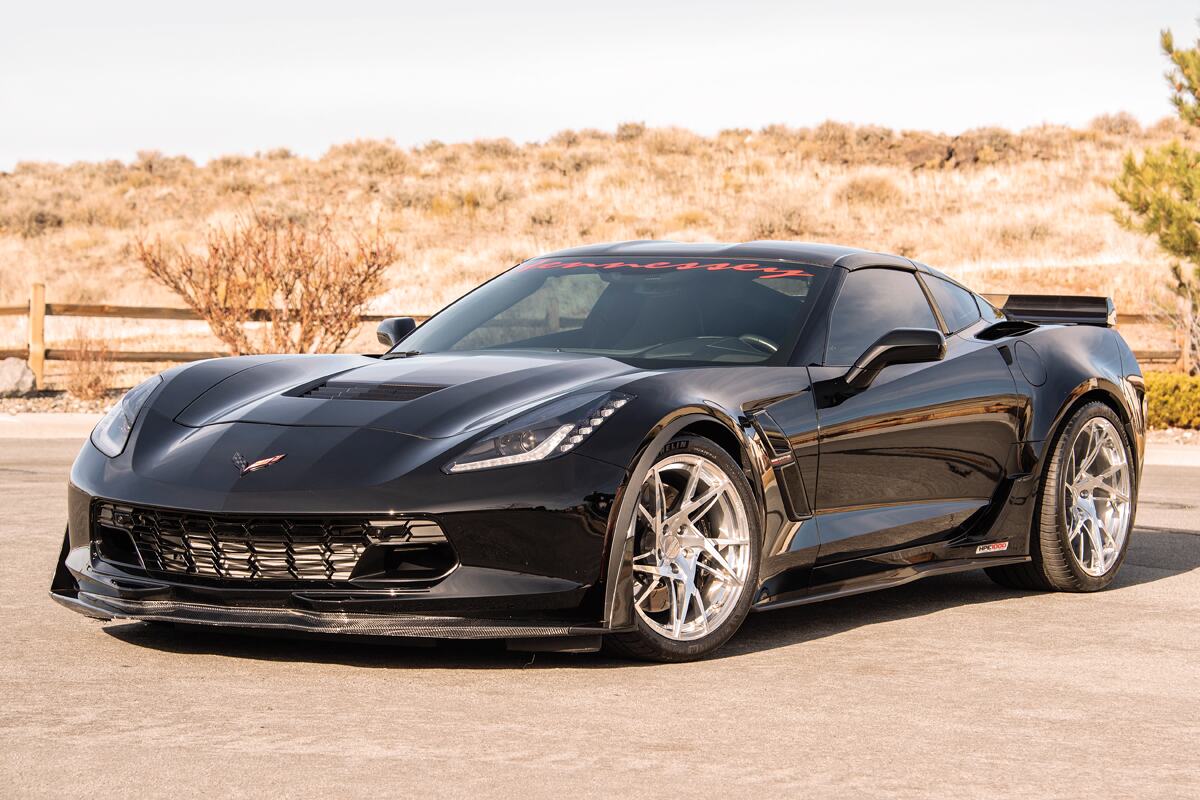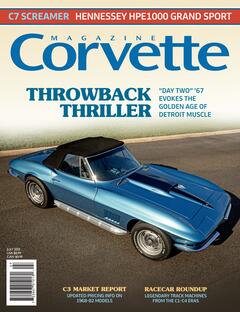Haggling over price is a familiar exercise for Corvette collectors. The details can get devilish, though, as John Toney can attest. How he came to acquire his latest Hennessey-enhanced C7 Grand Sport—after owning four other Vettes previously, ranging from a ’91 model to a 2021 Z51—is an illuminating lesson in negotiation that car buyers of all stripes will relate to. But before we get into that aspect, let’s take a look at some of the compelling features of Toney’s 2019 Hennessey HPE1000, and how he put them to good use for some hairy hijinks in the high-desert hinterlands.
You’re likely already familiar with the Hennessey name, as this Sealy, Texas-based company was founded more than three decades ago and has since modified more than 15,000 cars and trucks of all domestic brands. ProCharger has been supplying its centrifugal superchargers to Hennessey since 2009, and claims to have been first to market with its C7 setup.
While Hennessey offered several levels of output for the seventh-gen Corvette, the HPE1000 model’s abundant dose of power represented the lineup’s performance apex. The “836” on Toney’s license plate isn’t precisely accurate, though. The dyno sheet supplied by Hennessey with each car shows a more than doubling of output, from the factory figure of 398 hp to 831 horses at the rear wheels, and 1,000 hp at the crank.

This numerical discrepancy came about unintentionally, as Toney originally wanted a personalized plate reading “HPE1000,” but the DMV computer curiously wouldn’t accept this input. Toney didn’t happen to have his dyno sheet with him, and didn’t want to lose his place in line at the DMV, so he just estimated the rear-wheel figure on the spot. (And, truth be told, dyno numbers can vary slightly depending on the operator’s skill as well as climatic conditions.)
As for how the tuner handled the engine mods, Erik Radzins from ProCharger summed it up succinctly: “Hennessey makes one heck of a combo by taking a larger-cubic-inch forged motor and bolting on [our] ProCharger F-1A-94 supercharger kit.”
The F-1A is notable for being a step up from ProCharger’s more commonly used (on street cars) P-1SC blower in terms of output, while remaining compact enough to fit within the C7’s tight engine bay. It’s also capable of supporting up to 1,100 horsepower, making it perfect for the HPE1000 package.

In addition to high-flow forced induction, specifics on the modifications to the engine included enlarging the swept piston volume to 416 cubes with a 4.0-inch stroker crank. The fortified mill was also blessed with CNC-ported and flow-tested cylinder heads, extreme-duty dual valve springs, and lightweight, hollow-stem valves. Larger fuel injectors help keep up with the increased airflow, while the throttle body was modified as well.
The reciprocating mass consists of forged aluminum pistons yielding a high (for a blown engine) 10:1 compression ratio, along with a set of 6.125-inch billet H-beam rods and one of HPE’s hotter hydraulic-roller camshafts. Venting the exhaust gases are 1.75-inch, stainless steel long-tube headers, dumping into a “mid-pipe” upgrade and freer-flowing catalytic converters.
After all these modifications were done, Hennessey performed both a chassis dynamometer pull, to verify output, and a 100-mile road test, in part to tune the Grand Sport’s factory Magnetic Ride Control Suspension for the massive increase in power. The tuner claims a (presumably traction-limited) 0-60 mph sprint of around 2.5 seconds, along with quarter-mile runs in under 10 ticks. Top speed is in the neighborhood of 220 mph, depending on the exact setup.

In looking back at his various vehicles over the years (starting with a ’64 Chevy SS when he was only 18 years old), Toney is impressed by the level of engineering of newer Corvettes, along with Hennessey’s performance ministrations. “The technology that a newer Corvette has is amazing,” he says. “Being able to adjust the level of exhaust, dampen steering and suspension from inside the car—there’s so much going on, I can’t grasp it all.”
In addition, he points out that Hennessey only produces a limited number of HPE1000 Corvettes, making them rare and highly desirable among performance-car enthusiasts. His car is Serial No. 1 for 2019. “With 1,000 horses at the crank, the HPE1000 Corvette competes with supercars, but at a fraction of the price,” he notes.
Speaking of the price, and the negotiations surrounding it, Toney’s background as a cost estimator for a commercial construction company came in handy, as he knows his way around an invoice. He came across the already-modified car online in Reno, and sent two e-mails to the dealer that went unanswered. Being the persistent type, and obviously fond of Corvettes, Toney made a call and found out the asking price was $120,000—significantly less than when the car sold new, possibly because the odometer had clocked some 7,500 miles. But his gut told him to hold off, even though C7s in general are holding their value well, due in part to being the last of the front-engine Corvettes. “So I scrapped the idea of purchasing the car,” Toney admits, “as I thought they were asking too much.” Then something surprising ensued.

“The next day I received a text from the sales manager asking, ‘Is this the John Toney that I sold a 1991 Corvette to?’” Sensing an opening for dickering, Toney called him back and later visited the dealership in person. The car wasn’t on the lot when he arrived, but the asking price had dropped to $115,000, still too much in Toney’s learned estimation. “Sight unseen, I offered $92,500 and then left to go home.” A couple of hours went by before the dealership came back with a $94,200 counteroffer, which Toney readily accepted.
Since acquiring the Hennessey, Toney has made only a couple modifications to the factory package: Aerollari rims (10 × 19 inches front, 12 × 20 rear), wrapped with Michelin Super Sport all-weather tires (P285/30ZR19 front, P335/25ZR20 rear). Also, he applied some red accents under the hood, along with carbon-fiber ground effects, in addition to the Grand Sport C7’s carbon hood and top. Thus far the car has been trouble free, needing only regular oil changes with 5W30 Mobil 1, even after some hard use.
Toney shared with us the details of a high-speed experience with the car, one involving a trip with fellow members of the Reno Corvettes club. A group of them headed east from Reno on Highway 50, dubbed the “Loneliest Road in America” for its forsaken ribbon of asphalt that stretches through the desert landscape.

The club stopped for lunch at a diner in Middlegate, Nevada, formerly a waypoint for the Pony Express and, later on, the site of an intersection on the Lincoln Highway. This hamlet was also where author Stephen King once stayed for a week while writing his novel Desperation, and it also served as the location for the award-winning film Black Road.
After a bite to eat, Toney and a couple fellow Corvette owners dropped the hammer on their way home, maintaining a blistering speed of 150 mph for more than a half-hour. Nary a cop was in sight the whole way back to Reno, and only a near-empty gas tank forced them to slow down. Running that hard is actually easier than it might sound. “I didn’t even notice the speed—the faster you go, the smoother the ride,” Toney points out. “But it’s noisy at 150 mph…that’s the only way you could tell.”
Despite attending the Ron Fellows high-performance driving school on three separate occasions, Toney doesn’t get overconfident when driving his hellacious Hennessey. “It’s scary fast,” he admits. “It can get you in over your head.” One of his big takeaways he recalls from his on-track training?
“When coming into a turn, brake hard, well before [you get there],” he advises, pointing out how the weight transfer to the front tires helps when carving the corner. “Then wind it out on the exit.” For a Corvette owner—and particularly one with 1,000 supercharged horses at his command—it doesn’t get any better than that.





